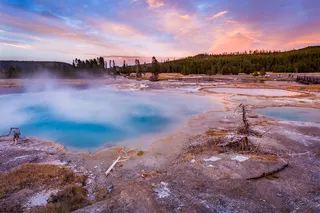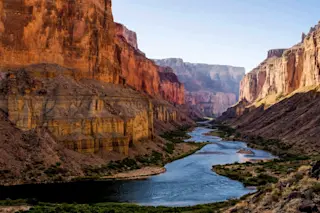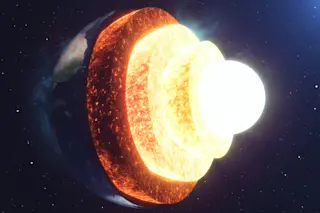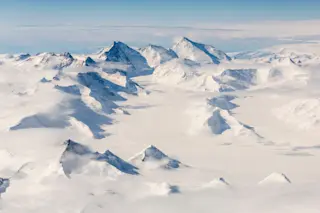This is the second in a series of guest posts by science writer Eli Kintisch, author of
Hack the Planet: Science’s Best Hope–or Worst Nightmare–for Averting Climate Catastrophe
, and climate change reporter for Science
magazine. We’ve invited Kintisch to contribute regular guest posts at the Intersection on the topic; my take on his excellent book, just out from John Wiley, is here.
In this latest post, Kintisch has contributed a small excerpt from Chapter 10 of his book, on the subject of how conservatives are exploiting geoengineering. Some lines have been edited for clarity in this shortened form, and the full chapter quotes this essay by Alex Steffen.
Why do some of the same people who believe human activities are not warming the globe—or that climate change isn't a crisis—feel that geoengineering is required to fix the problem?... Like a climate policy Swiss Army knife, geoengineering has proven useful to support a number of talking points on the subject. First, the promise of geoengineering as a technical fix to the problem has allowed conservatives to present a solution to global warming instead of being seen as simply blocking liberals’ proposed carbon regulations. Furthermore, strategies that involve blocking the sun turn a pollution problem--there’s too much carbon dioxide in the air—into a temperature problem—it’s too hot. By championing a technique that directly alters the temperature of the planet instead of the composition of the atmosphere, conservative advocates of geoengineering have a “solution” that fits the argument they been making all along. And conservatives cite liberal distrust of planet-hacking as evidence that they don’t really want to solve the problem—or even that they have more ulterior motives. The spring of 2008 would see geoengineering emerge as a new focus for the right wing of the climate policy crowd. In June of that year, the American Enterprise Institute, Washington’s premier right-wing think tank, embraced the push for geoengineering research with the first of six planned workshops on the topic. Former Deputy Secretary of Defense Paul Wolfowitz and leading nuclear hawk Fred Ikle of the Center for Strategic and International Studies were part of an invitation-only discussion of geoengineering hosted by the Council on Foreign Relations. Though more contrarian than politically partisan, the 2009 book Superfreakonomics: Global Cooling, Patriotic Prostitutes, and Why Suicide Bombers Should Buy Life Insurance provided new fuel to the yes-to-geoengineering-no-to-emissions-cuts position. Authors Stephen Dubner and Steven Levitt acknowledged a risk that “the greenhouse gases we've already emitted do produce an ecological disaster.” But launching a global crash program to lower carbon emissions is a “costly, complicated” solution, they wrote. Transforming the energy system to reduce carbon emissions? Shouldn’t be “dismissed,” they wrote. But they quoted approvingly from scientists who called wind power “cute” and solar power "probably not” a good solution—and they basically ignored the potential of nuclear power. Geoengineering? A “fiendishly simple plan.” And Bret Stephens of the Wall Street Journal opinion page applauded the bestseller. He called it “delightful.” But it can be difficult to remain scientifically credible while questioning the link between man-made carbon dioxide and global warming. Dubner and Levitt faced intense criticism from a variety of researchers in large part because Superfreakonomics raised doubts about a variety of aspects of settled climate science, most notably the atmospheric role of carbon dioxide. That gas, they assert, does not “necessarily” warm the earth. “So hopelessly wrong,” was how climate modeler William Connolley described the book before listing 10 errors or obfuscations. Having responded directly to few scientific critiques, Dubner and Levitt characterized their attackers as “ideological” opponents or, tellingly, “carbon crazies.” Others have offered geoengineering as an alternative option to emissions cuts after arguing that the latter won’t solve the problem. In 2009 Alan Carlin, an economist at the U.S. Environmental Protection Agency suggested that the Pinatubo Option was preferable to cutting emissions because it was cheaper and because, unlike reducing greenhouse gases, “it would actually work.” Carlin told me in 2008 that geoengineering could not only protect us from warming but also, depending on what techniques were used, would allow humanity to prevent “the next ice age” in case it comes. “Geoengineering would provide more time for the world’s economy to grow while investors and entrepreneurs develop and deploy new carbon-neutral energy sources to replace fossil fuels,” wrote Ronald Bailey of the magazine Reason. Teller, for his part, wrote in his 1997 Wall Street Journal op-ed piece that geoengineering “is not a new concept and certainly not a complex one.” The AEI’s Sam Thernstrom states that cooling the planet using the Pinatubo Option offers “three powerful virtues in a climate policy that mitigation, at the moment, cannot claim.” They were, he said, “fast,” “affordable,” and “effective.” The problem with the argument that geoengineering can be used to forestall emissions cuts is that every ton of carbon dioxide that gets emitted into the air while we’re delaying could increase the future calamity. Even Tom Wigley of the National Center of Atmospheric Research, a staunch supporter of geoengineering research, believes it could only be used simultaneously with emissions cuts, as soon as possible. The longer we wait to geoengineer, the more severe the geoengineering we might need in the future – hence the greater chance of side effects. Scientists who have studied radical geoengineering approaches hardly consider them “simple” or, as Thernstrom calls the Pinatubo Option, “effective.” It's one thing to say that geoengineering techniques appear as though they would cool the planet and so they should be studied. It's another to say they're good enough to be considered an alternative to getting to the root of the problem, too much carbon dioxide. The extent to which they’re “affordable” is also up for debate… “How can you vote on which solutions are most cost-effective if you don’t even know if they work?” wondered environmental scientist Alvia Gaskill, a prominent member of the Geoclique. Conservatives have used the reservations that scientists and climate activists have with the radical idea of geoengineering as proof of nefarious aims. The argument goes that if you are uncomfortable with planet-hacking but support tackling the climate crisis with emissions cuts you are seeking political control, money, or vast political change. The Toronto Globe and Mail’s Reynolds wrote approvingly that the Pinatubo Option “would require no changes in lifestyles, no sacrifice in standards of living . . . perhaps this helps explain why it is neither discussed nor researched by environmentalists or governments. The belief that liberal environmentalists could never support geoengineering research led David Schnare to declare that advocates for planet-hacking research “have no friends” in the Obama administration. But liberals are calling for geoengineering research, including environmental pioneer Stewart Brand, ecologist Tom Lovejoy and climate advocate Rafe Pomerance. And in the Obama administration, Secretary of Energy Steve Chu, has said that painting exterior surfaces such as roofs white to reflect sunlight could be a positive step to combat global warming – a technique unrelated to greenhouse gas controls. His science deputy Steve Koonin and White House Science adviser John Holdren organized meetings on geoengineering before they joined the administration. There’s real basis for the concern that the concept of planet-hacking could be misused for political ends. Former National Coal Board scientist Richard Courtney is among Britain’s biggest opponents of emissions cuts, and he says “I do think the possibility of geoengineering should be supported. My reason for this is a political ploy…the politicians need a viable reason if they are to back off from this commitment to [carbon] constraints without losing face.” In April 2009, Michael Totty, an editor at the Wall Street Journal, asked climate scientist Ken Caldeira over a series of e-mails to write a “strong advocacy piece” about geoengineering for a special pullout section of the newspaper on the environment. Caldeira was wary, so Totty suggested that Caldeira write that “all the attention on mitigating the cause of global warming is causing us to ignore a crucial strategy” and that “we’re going to have to take this whole different approach.” Totty called it “Geoengineering Now.” “I have problems with the implication that we need to take a ‘different’ approach, rather than ‘an additional approach,’” Caldeira wrote back to the editor. He declined the assignment.
You can order Hack the Planet: Science’s Best Hope–or Worst Nightmare–for Averting Climate Catastrophe
from Amazon.com. Also, don't miss Kintisch's appearance with me on Point of Inquiry--listen here.













